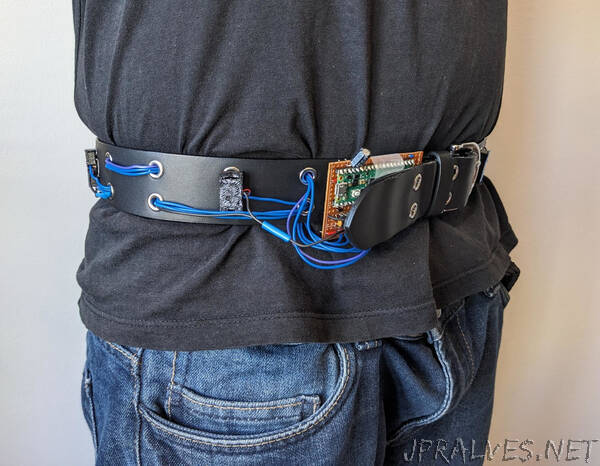
“I’ve always wanted to build a compass belt! The idea is to attach a couple of vibration motors to a belt, use a compass sensor to find north, and then to let the motor that points north vibrate!
Wearing such a device seems to give some people a new sense of direction, so I was super curious to try it!
In this post, I want to document how I built one, hoping to give other people who want to build one in the future a head start! My design is cheap (the parts cost around 15 EUR) and has a straightforward design.
Overall design
The simplest implementation I could think of was to use a microcontroller to control the vibration motors, and then connect it to a smartphone via USB, to receive commands.
This means that we don’t an extra magnetic sensor, and no battery pack, because we can use the smartphone as a power supply. This is the finished compass belt in its current form:
Hardware
Belt
I found this belt at a clothing store a couple of weeks ago, and immediately thought that it might be a neat basis for this project! Any belt with double rows of eyelets all the way along the belt should work. If you don’t find such a belt, you’d need another way to mount the motors, and to route the cables.
Motors
I used coin vibration motors with a diameter of 10 mm, a nominal voltage of 3 V, and a nominal current of 70 mA. These “closed” motors have the advantage that they don’t have external moving parts you need to look out for.
Board
The electronics of the belt are based on a Raspberry Pi Pico, a tiny, cheap microcontroller with lots of output pins.
It’s not a good idea to attach the motors to the output pins of the Pico directly, as they are not designed to provide enough current.
So I asked around a bit, and Kenneth and Electronic Eel suggested using a transistor array chip called the ULN2803a (which is similar to the ULN2008A, but has 8 input and output pins). The ULN can be used to connect and disconnect the motors to the ground on demand. They also already contain a “flyback diode”, which will prevent the transistors from being damaged when the motors wind down.
Electronic Eel also helped me with finding suitable capacitors: One 100 nF capacitor acting as a bypass capacitor per ULN, and a bigger one (I used 220 µF) for stabilizing the voltage of the Pico itself.”
